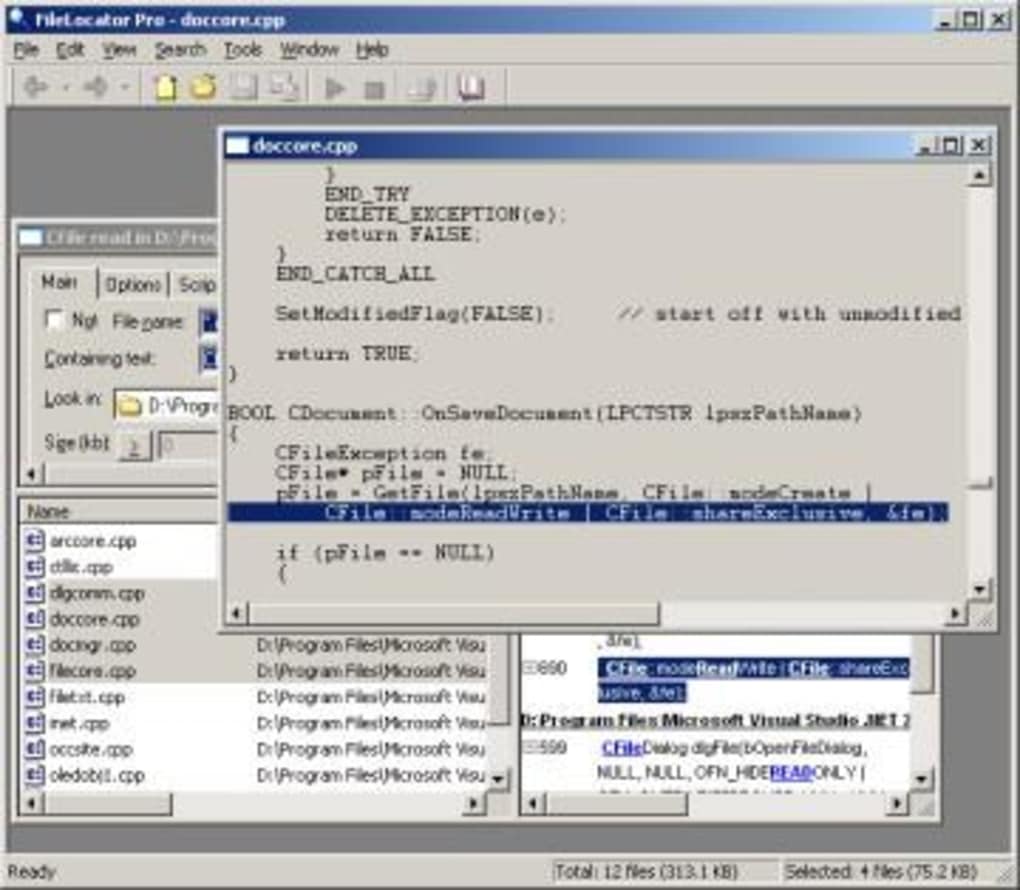

- #Filelocator pro boolean regex how to
- #Filelocator pro boolean regex serial
- #Filelocator pro boolean regex plus
The following list contains additional resources for more information about using RegEx:
#Filelocator pro boolean regex plus
+ as a quantifier instead of the literal plus sign character.

If the + sign is not escaped with a backslash, RegEx treats
#Filelocator pro boolean regex how to
The following table gives an example on how to escape a reserved metacharacter when searching. When using RegEx to search for a character that is a reserved metacharacter, use the backslash \ to escape the character so it can be recognized.
RegEx: only permits for 2Ĭharacter, or character group, occurs at least n times, and at most m times.ĭigit, thus outside of the character range. Pattern: 4 letters-4 digits-4 letters-4 digits. #Filelocator pro boolean regex serial
This single RegEx returns any document that contains any of the three serial numbers. Instead of writing three literal search strings to match each serial number, you can construct one regular expression to match the serial numbers’ pattern. For example, the following serial numbers: RegEx can help you in cases where you need to find different numbers that contain the same pattern.
Using regular expressions with dtSearch. This page contains the following sections:įor more information about other uses for RegEx, see the following: The differences in implementations usually include the way special characters are handled and how character classes are treated. There are several implementations of RegEx. “d” stands for the literal character, “d.” You can use regular expressions to search for social security numbers, patent numbers, URLs, email addresses, Bates numbers, and other strings that follow a specific pattern. For example, “\d” in a regular expression is a metacharacter that represents a digit character. Metacharacters are the building blocks of regular expressions. From perlsyn under 'Truth and Falsehood'. When evaluated as a string it is treated as, but as a number, it is treated as 0. Negation of a true value by '' or 'not' returns a special false value. RegEx uses metacharacters in conjunction with a search engine to retrieve specific patterns. The number 0, the strings 0 and, the empty list ' ()', and 'undef' are all false in a boolean context. With RegEx you can use pattern matching to search for particular strings of characters rather than constructing multiple, literal search queries. Only with boost::cpp_regex_traits can a locale of type std::locale be passed to imbue().Searching with Regular Expressions (RegEx)Ī regular expression is a form of advanced searching that looks for specific patterns, as opposed to certain terms and phrases. With the second template parameter of boost::basic_regex, the parameter for imbue() can be defined indirectly. Std::string s = "Boost k\xfct\xfcphaneleri" The third function offered by Boost.Regex is boost::regex_replace() (see Example 8.3). The first substring that matches the first group is accessible at index 1. This implies that results are accessible only as long as the corresponding string, which is referenced by the iterators, exists.įurthermore, please note that the first element of the container boost::smatch stores iterators referencing the string that matches the entire regular expression. Please note that because iterators are used to point to matched strings, boost::sub_match does not copy them. FileLocator Pro can be configured to match the expression across the whole file (default) or on a line by line basis in the Options Tab. Using the overloaded operator operator<<, the substring can be written directly to standard output. FileLocator Pro's Boolean expression engine supports Web style search expressions using the AND, OR, NOT, NEAR, REGEX, and LIKE operators. However, to write a substring to the standard output stream, you don’t have to access these iterators (see Example 8.2). Because boost::sub_match is derived from std::pair, the iterators that reference a particular substring can be accessed with first and second. They can be used to search, edit, or manipulate text and data. A regular expression is a special sequence of characters that helps you match or find other strings or sets of strings, using a specialized syntax held in a pattern. The class boost::sub_match stores iterators to the specific positions in a string corresponding to the groups of a regular expression. Java regular expressions are very similar to the Perl programming language and very easy to learn. For example, elements can be accessed via operator. 
The result storage class boost::smatch is a container holding elements of type boost::sub_match, which can be accessed through an interface similar to the one of std::vector. That’s why Example 8.2 returns two strings based on the two groups found in the regular expression. boost::regex_search() only searches for groups. Std::cout << what << "_" << what << '\n' īoost::regex_search() expects a reference to an object of type boost::smatch as an additional parameter, which is used to store the results.







 0 kommentar(er)
0 kommentar(er)
